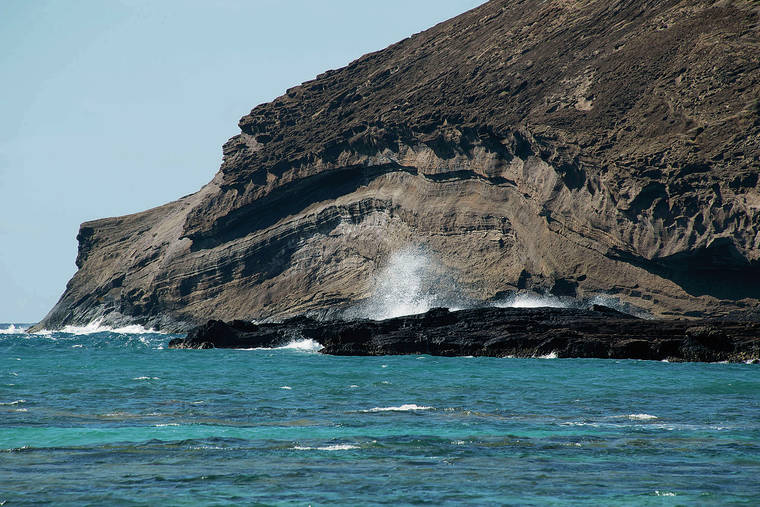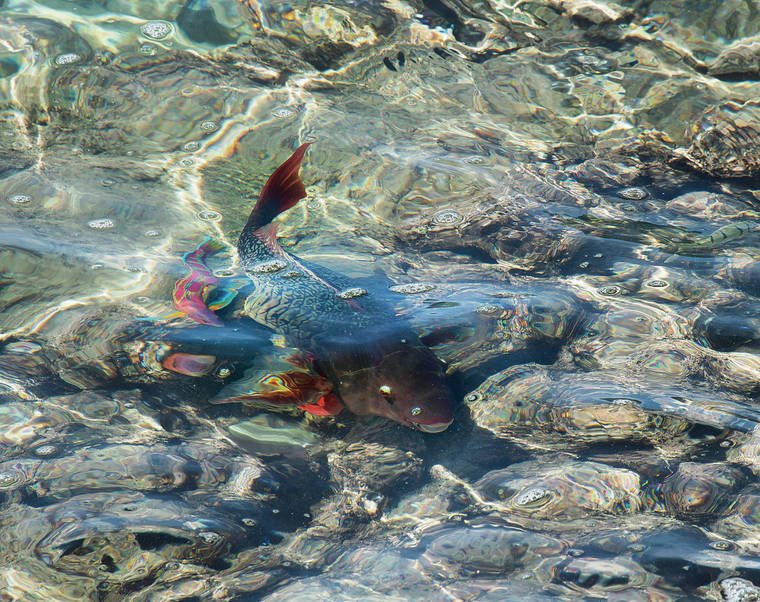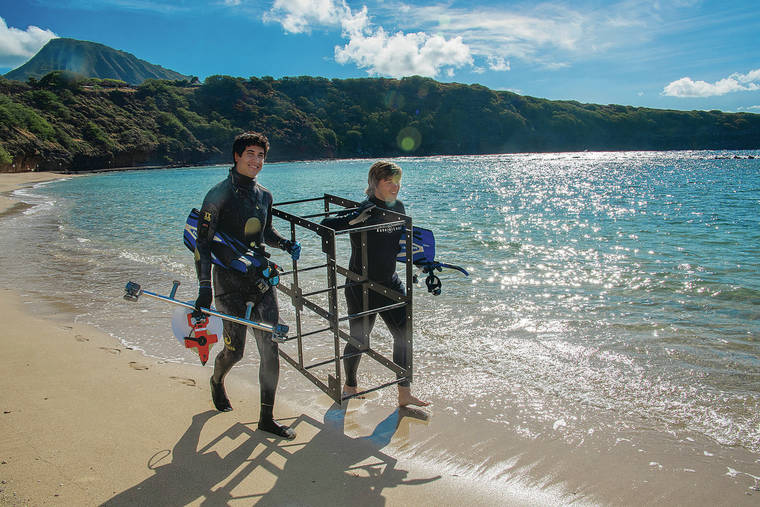Brief absence of humans shows remarkable changes in Hanauma Bay


CRAIG T. KOJIMA / CKOJIMA@STARADVERTISER.COM
Visitors tend to stay away from swimming in the Witches Brew area of Hanauma Bay because the waves are rougher.

CRAIG T. KOJIMA / CKOJIMA@STARADVERTISER.COM
Fish were feeding about 30 feet offshore at Hanauma Bay on Thursday.

CRAIG T. KOJIMA / CKOJIMA@STARADVERTISER.COM
Lab technician Andrew Graham, left, and intern Matt Stefanak of the Coral Reef Ecology Lab of the University of Hawai‘i at Manoa Institute for Marine Biology carried a calibration cube used to take 3-D images and video of the fish at Hanauma Bay.




Seen from above on early Thursday morning, the 101-acre amphitheatre of Hanauma Bay spread out in all its primeval glory: the 2,000-foot-long, white crescent of beach crossed by a single track of footprints; luminous, transparent water in gradations of turquoise over white sand channels and leopard spots of reef; rougher, deep blue sea out where the wrap-around lava cliffs of the eroded volcanic cindercone tapered to points, curving in like giant crab claws.
“The left point of the bay is called Palea, ‘brushed aside,’ and the right point is Pai‘olu‘olu, ‘lift gently,’” writes John Clark in his “Beaches of O‘ahu,” adding that Hanauma means both curved and hand-wrestling bay, the latter after the “uma” that was practiced there to entertain alii such as Queen Kaahumanu; it was also a favorite fishing camp of Kamehameha V.
In Hawaii’s post-World War II tourism boom, the hana became so popular that Hanauma Bay Nature Preserve and Marine Life Conservation District was receiving an average 3,000 visitors every day (except Tuesdays, Christmas and New Year’s) before it closed to the public indefinitely March 26 under Honolulu’s coronavirus emergency Opens in a new taborder Opens in a new tab.
During the ensuing two months, the only people entering the preserve, besides regular maintenance and security staff with the Honolulu Department of Parks and Recreation, have been teams of five or fewer scientists at a time, studying the status of coral, water quality and fish behavior during this unprecedented, visitor-free time.
“The water is different, clearer,” said Ku‘ulei Rodgers, principal investigator at the Coral Reef Ecology Lab of the University of Hawai‘i at Manoa Institute for Marine Biology, as she walked at the water’s edge in the clean, salty air free of sunscreen fragrances, and a quiet broken only by her soft voice, birdsongs and the sound of wind and waves; sky and sea were free of planes and boats.
Don't miss out on what's happening!
Stay in touch with breaking news, as it happens, conveniently in your email inbox. It's FREE!
“The water appears clearer now, overall, than it used to look on Tuesdays, when our survey found it was 30% clearer on closed days than days when it was open,” Rodgers said, referring to her “Hanauma Bay Biological Carrying Capacity Survey,” conducted from May 2018 to May 2019, coauthored with Sarah Severino, which assessed stress on corals from human activities.
The survey measured visitor use by snorkelers and waders and reported that the highest water clarity was measured offshore, “where little human disturbance was recorded.”
Rodgers cautioned that her team’s observations of water turbidity (cloudiness), pollution, coral regeneration and fish behavior during the closure, compared with before, were “just anecdotal; we can’t know for sure until we complete our studies — we won’t actually know if it’s a change until we study what it’s like after people come back.”
That said, “We’re seeing fish coming closer to us when we’re swimming, not moving off to one side like they used to,” she added as she paused on the sand at the Koko Head end of the beach to point out the many different colorful fish — kalani, uhu (a large blue parrotfish) humu humu, manini, kika kapu, kapuipui—flickering through the shallows and eating algae off the coral and lava rocks of Backdoors, one of five principal sectors on the reef her team is studying; the 2019-20 survey, which focused on fish and visitors, was recently completed.
“And also anecdotally, we’re seeing bigger fish, predators, like 2-1/2-foot-long papio (young ulua, or jacks) coming in closer to shore,” she said. “We’re used to seeing them at Witches Brew (the sector at the Ewa end of the bay) but not here at Backdoors, where the other day, as we were wading, one swam right up past our legs.”
She pointed out a large pakuikui (Achilles tang), colored black with an orange tail bright as a monarch butterfly’s wing. And weke, api (an orange and teal surgeon fish, or tang), pyramid and threadfin butterfly fish, a rosy Christmas wrasse, and big maneoneo (sailfin tang, black with orange stripes).
“The Hawaiians spent a lot of time here. I can see why,” Rodgers said with a smile.
The tide was low and rising. Gentle, slow swell lines rolled in, breaking on the barrier reef halfway across the bay and sending whitewater fanning toward shore; plumes of white spray leapt on the cliffs as the sea heaved against the lava-rock ledges.
“Last year, we counted how many people were in each sector of the bay: Keyhole is the most popular,” Rodgers said, pointing out a notched turquoise lagoon Ewa of Backdoors.
The next sector was Channel, in the center of the bay, marked by tall buoys, where a school of amaama (striped mullet) could usually be found, she said, and then Witches Brew, where fewer tourists swam because “the waves are rougher and there’s more turbid water.”
There was also “a lot more (living) coral in Witches Brew and it’s growing horizontally, not only on vertical surfaces and in cracks, like where more people snorkel,” Rodgers added, explaining that coral growing horizontally, in the open, was more vulnerable to being kicked, bumped or stepped on by snorkellers.
The beach sands were also different at Witches Brew, made of green-brown, volcanic olivine rather than white coral and shells.
A clear picture
On the shore, dressed in full wetsuits, two of Rodgers’ team — Andrew Graham, a lab tech, and Matt Stefanak, an intern — were preparing to swim out and conduct fish transepts, measuring how close fish let people approach in different sectors of the bay.
One of them held a large white secchi disk, while the other swam away from him and toward a fish with the transept line, marking the spot where the fish turned away.
“With most of them we can get within 1 meter or less before they swim away,” Stefanak said. “Outside protected areas (where fishing is banned) it’s more like 10 meters.”
“The water quality’s nice today, with 11-12 meters visibility,” Graham said, noting that turbidity, or the amount of particles and sediment suspended in the water, varied with the weather in addition to the numbers of snorkellers that, for the time being, weren’t a factor except for their absence.
The scientists were also using a calibration cube, which had two cameras set at a precise angle to get full 3-D images and video of fish behavior and distancing.
“Some of the big uhu let you come so close you could almost touch them, but we won’t know if they’re letting you come closer or farther than they do with lots more people until we compare their behavior when people return,” Graham said.
“If normally there’s worse visibility, maybe the fish don’t see you until you get closer,” he added.
Like Rodgers, the two reported seeing large ulua, including a 30- to 40-pound. specimen, and 15-pound. umilu in the shallows of the bay; they‘d also been seeing up to two monk seals at a time resting on the beach every week, when even one monk seal had been a rare sight before the shutdown.
Taking in the quiet
Walking back to the grassy lawn and shady grove of tall coconut trees at the center of the bay, Rodgers, 64, who grew up in Aina Haina, said the quiet, uncrowded bay reminded her of the closeness to nature she felt while camping here in her summer fun program as a child.
Holding up a finger ringed with a scar from “where an eel bit me,” she said she wished that, before it reopens to the general public, Hawaii residents could be allowed to come back in limited numbers to the bay and experience it this way.
Also, if people come back gradually, “we might see some recovery” of the coral, Rodgers said, noting that nearly half the bay’s coral had been decimated by a 2014 bleaching event due to warmer seas produced by climate change; while a couple of clusters were recovering and showing “healthy color,” coral grow very slowly.
Although one of the coral reef lab scientists was monitoring baby coral polyps, it was unlikely that, during a couple of months’ closure, they would see new coral attached and growing on the reef before visitors returned, Rodgers said.
Another scientist, specializing in very large marine animals, had just arrived and was standing at an overlook on the road up the cliff. He was George Balazs, who has been studying green sea turtles and working for their conservation since 1971; at Rodgers’ invitation, he had been visiting the closed bay once a week to look for honu.
The retired former researcher with the National Oceanographic and Atmospheric Administration in Hawaii said he’d seen three honu in the Backdoors and Keyhole channels, but these were the first turtles he’d seen in his four visits to the closed bay, so far.
“Clearly, not having tourists here is not causing the turtles to come around,” Balazs said with a wry grin.
It was time to leave. In a last look back at the blue bay, a black-and-orange butterfly flew past and hovered against the wind at the cliff’s edge for a moment before diving down toward the sea.
Returning to the nearly empty parking lot, devoid of tour buses and trolleys and rental cars, one felt far from civilization and reluctant to return to town.



